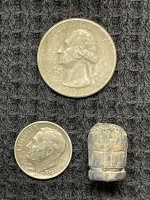Marius
Full Member
I'm sure some one ask you guys before..but..
Since xt 70 isn't really gold prospecting machine,so it will be wasting of time to go with it to Nevada gold fields?
(i did got that oval coil with should be better for gold)
Any imput ?
Anyone found nuggets with xt70?how deep?
(just got small 3g gold nugget to adjust machine always before prospecting.)
Since xt 70 isn't really gold prospecting machine,so it will be wasting of time to go with it to Nevada gold fields?
(i did got that oval coil with should be better for gold)
Any imput ?
Anyone found nuggets with xt70?how deep?
(just got small 3g gold nugget to adjust machine always before prospecting.)
Upvote
0

























 click link):
click link): 




